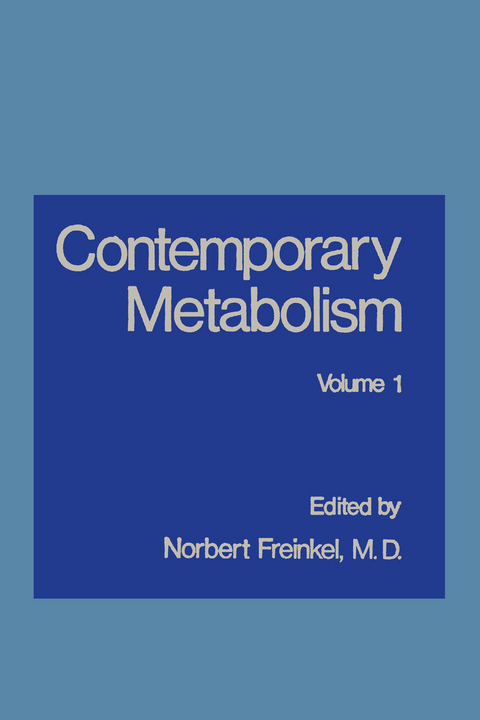
Contemporary Metabolism
Springer-Verlag New York Inc.
978-1-4684-3449-1 (ISBN)
Despite a new title, Contemporary Metabolism, Volume 1 is actually the third volume in a continuing series and succeeds The Year in Metabolism 1975- 1976 and The Year in Metabolism 1977. As in the earlier volumes, the same internationally recognized authorities review the noteworthy recent devel opments in their areas of expertise. In many instances they also address aspects that have not been considered previously. In this volume, Dr. J. Edwin Seegmiller again updates progress in understanding disorders of purine and pyrimidine metabolism. However, particular emphasis is placed on the emerging relationships with immune mechanisms. Dr. Charles S. Lieber is joined by Dr. Enrique Baraona in a continuing review of metabolic actions of ethanol. This chapter examines effects of ethanol on protein metabolism and selected features of lipid metabolism-two areas that were not included in the earlier volumes. Dr. DeWitt S. Goodman's review of disorders oflipid and lipoprotein metabo lism builds on his previous chapters, but much additional attention is directed to a critical analysis of recent advances in epidemiology and lipoprotein structures. In collaboration with Dr. Brian L. G. Morgan, Dr. Myron Winick devotes his entire chapter to a detailed review of the impact of nutrition upon brain development-an overview that has now been rendered possible by the burgeoning recent developments in this area.
1 Disorders of Purine and Pyrimidine Metabolism.- 1.1. Introduction.- 1.2. Purine Metabolism.- 1.3. Adenosine Deaminase Deficiency Associated with Severe Combined Immunodeficiency Disease.- 1.4. Purine Nucleoside Phosphorylase Deficiency.- 1.5. Biochemical Basis of the Immunodeficiency in Adenosine Deaminase and Purkie Nucleoside Phosphorylase Deficiency.- 1.6. Purine 5’-Nucleotidase Deficiency in Hypogammaglobulinemia.- 1.7. Adenine Phosphoribosyltransferase Deficiency.- 1.8. Hypoxanthine-Guanine Phosphoribosyltransferase Deficiency.- 1.9. Increased Phosphoribosyl-1-Pyrophosphate Synthetase Activity.- 1.10. Xanthinuria.- 1.11. Gouty Arthritis.- 1.12. Decreased Adenylate Deaminase Activity.- 1.13. Abnormalities of Pyrimidine Metabolism.- 1.14. Abnormalities of DNA Repair (Xeroderma Pigmentosum).- 1.15. Purine and Pyrimidine Compounds as Inhibitors of Viral and Cellular Proliferation.- References.- 2 Metabolic Actions of Ethanol.- 2.1. Effects of Ethanol on Protein Metabolism.- 2.2. Effects of Ethanol on Lipid Metabolism.- References.- 3 Disorders of Lipid and Lipoprotein Metaboiism.- 3.1. Introduction.- 3.2. Lipoprotein Structure and Metabolism.- 3.3. Type III Hyperlipoproteinemia.- 3.4. Tangier Disease.- 3.5. High-Density Lipoprotein Levels and Coronary Heart Disease.- 3.6. Cholesterol Metabolism and Its Regulation.- 3.7. Familial Hypercholesterolemia.- 3.8. Chronic Renal Failure and Hyperlipidemia.- 3.9. Hypertriglyceridemia.- 3.10. Hyperlipidemia and Its Treatment.- References.- 4 Nutrition and Cellular Growth of the Brain.- 4.1. Methods for Producing Early Malnutrition.- 4.2. Malnutrition and Brain Size.- 4.3. Malnutrition and Cellular Growth of the Brain.- 4.4. Malnutrition and Myelination.- 4.5. Other Effects of Malnutrition on the Growing Brain.- 4.6. RegionalChanges Induced by Malnutrition.- 4.7. Malnutrition and Cellular Growth of the Peripheral Nerves.- 4.8. Malnutrition and Cellular Growth of the Human Brain.- References.- 5 Metabolic Aspects of Renal Stone Disease.- 5.1. Introduction.- 5.2. Renal Stone Disease Secondary to Increased Crystalloid Excretion.- 5.3. Treatment of Renal Stone Disease.- References.- 6 Hormone Receptors, Cyclic Nucleotides, and Control of Cell Function.- 6.1. Introduction.- 6.2. Receptor Systems.- 6.3. Regulation of Adenylate Cyclase.- 6.4. Protein Kinases.- 6.5. Calcium Regulation of Cyclic Nucleotide Concentration.- 6.6. Cyclic Nucleotides in the Extracellular Fluids.- References.- 7 Diabetes Mellitus.- 7.1. Heterogeneity of Diabetes Mellitus.- 7.2. Insulin Secretion.- 7.3. Insulin Resistance and Insulin Receptors.- 7.4. Diabetes and Exercise.- 7.5. Diabetes and Pregnancy.- 7.6. Acidosis in Diabetes.- 7.7. Long-Term Complications.- 7.8. Treatment of Diabetes Mellitus.- References.- 8 Glucagon and Somatostatin.- 8.1. Anatomy of the Islets of Langerhans.- 8.2. Structure-Function Relationships of Glucagon.- 8.3. Pancreatic and Extrapancreatic Immunoreactive Glucagons.- 8.3.4. Immunoreactive Glucagon in Plasma.- 8.4. Glucagon Metabolism, Clearance, and Degradation.- 8.5. Actions of Glucagon.- 8.6. Control of Glucagon Secretion.- 8.7. Glucagonlike Immunoreactivity (Enteroglucagon).- 8.8. Somatostatin.- 8.9. Glucagon in Clinical Medicine.- References.- 9 Recent Advances in Body Fuel Metabolism.- 9.1. Introduction.- 9.2. Glucose Metabolism.- 9.3. Ketone and Fatty Acid Metabolism.- 9.4. Amino Acid Metabolism.- 9.5. Fuel Metabolism in Exercise.- References.- 10 What’s New in Obesity: Current Understanding of Adipose Tissue Morphoiogy.- 10.1. Introduction.- 10.2. Techniques for Measuring AdipocyteSize and Number.- 10.3. Cellularity of Adipose Tissue in Man and Animals.- 10.4. How Constant Is Adipocyte Number?.- 10.5. How Are New Adipocytes Formed?.- 10.6. Significance of Cell Size and Number in Energy Regulation.- References.- 11 Divalent Ion Metabolism.- 11.1. Introduction.- 11.2. Vitamin D.- 11.3. Clinical Disorders That Involve Altered Vitamin D Metabolism.- 11.4. Phosphorus Metabolism.- References.- 12 Metabolism of Amino Acids and Organic Acids.- 12.1. Pyruvate Metabolism and Its Disorders.- 12.2. Pyruvate Metabolism and Its Regulation.- 12.3. Specific Disorders of Pyruvate Metabolism.- References.
| Zusatzinfo | XXVI, 498 p. |
|---|---|
| Verlagsort | New York, NY |
| Sprache | englisch |
| Maße | 152 x 229 mm |
| Themenwelt | Medizin / Pharmazie ► Gesundheitsfachberufe ► Diätassistenz / Ernährungsberatung |
| Medizinische Fachgebiete ► Innere Medizin ► Diabetologie | |
| Medizinische Fachgebiete ► Innere Medizin ► Endokrinologie | |
| Studium ► 1. Studienabschnitt (Vorklinik) ► Biochemie / Molekularbiologie | |
| ISBN-10 | 1-4684-3449-7 / 1468434497 |
| ISBN-13 | 978-1-4684-3449-1 / 9781468434491 |
| Zustand | Neuware |
| Informationen gemäß Produktsicherheitsverordnung (GPSR) | |
| Haben Sie eine Frage zum Produkt? |
aus dem Bereich


